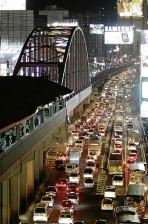Phase 1 hardest part of Edsa rehab, says DPWH chief

Edsa
When major road improvements on the 23-kilometer-long Epifanio de los Santos Avenue (Edsa) start next May, the patience of motorists and commuters using the country’s busiest thoroughfare will be tested.
But according to Public Works and Highways Secretary Rogelio Singson, this will be true only while phase one of the P3.7-billion project is underway.
Phase one involves the “stretch of Edsa from Roxas Boulevard (in Pasay City) to Julia Vargas Avenue (in Mandaluyong City),” he explained.
“While we’re working on Phase 1, the rest of Edsa will be open and traffic in those areas will be normal,” Singson said in radio interview Sunday.
He added that before road repairs begin on the stretch of Edsa from Pasay to Mandaluyong City, the Department of Public Works and Highways (DPWH) would first construct the elevated flyover at the intersection of Edsa and Taft Avenue.
The rehabilitation of the major thoroughfare will be done in three phases for 23 months under the DPWH’s Urgent Infrastructure Development Project, in time for the World Economic Forum in 2014 and the Asia-Pacific Economic Cooperation summit in 2015.
Singson said the department aims to replace all damaged concrete pavements to ensure road stability and the carrying capacity of the road.
Once completed, Edsa will soon become as “smooth” as the North and South Luzon Expressways (NLEx and SLEx), he added.
Singson, meanwhile, lamented the fact that the highway which was completed in 1954 had practically been neglected by previous administrations.
Edsa is proof that “our road standards have really gone down. We are settling for roads full of potholes,” he said.
“Only piecemeal repairs are being done there. Yet, we can have smoothness that can equal that of both NLEx and SLEx,” he added.
Last week, the road project was approved by the Metropolitan Manila Development Authority which has yet to map out alternate routes for motorists.
Aside from Edsa, the DPWH also plans to “restore Taft Avenue (which covers portions of from Manila and Pasay City) as a major thoroughfare.”
The road “has been taken over by vendors with sidewalks crammed with illegal structures that commuters end up waiting for their ride in the middle of the street,” noted Singson.
According to the DPWH head, the agency will “pursue the full pavement of primary roads and bridges nationwide by 2014 and 2016, respectively.”
The target covers 15,872 km of national arterial roads, 15,370 km of national secondary roads ad 7,958 bridges with a total length of 345,978 lineal meters, he said.
This year, the DPWH allocated nearly P23 billion to preserve the existing road network and another P26.2 billion to pave 1,175 km of gravel-type roads. An additional P7.9 billion will be used to upgrade bridges.
In the 2012 Global Competitiveness Report, the Philippines scored a low 3.1 points in road quality on a scale of 1 (extremely underdeveloped) to 7 (extensive and efficient by global standards).
Vietnam scored a much lower 2.6, while other Asian countries rated as follows: Singapore, 6.5; Hong Kong, 6.2; Japan and South Korea, both 5.8; Malaysia, 5.7; Taiwan, 5.6; Thailand, 5; China, 4.4; Indonesia, 3.5; and India, 3.4.














